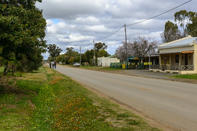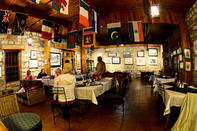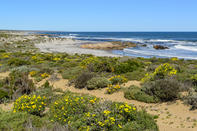A Charming Collection of Houses
As you head east on the R27 out of Vanrhynsdorp, the road runs dead-straight over the Knersvlakte towards the sheer wall of the Bokkeveld Mountains. At the foot of the massif, you’ll start to climb up the steep Van Rhyns Pass, built by the legendary road builder Thomas Bain in 1880.

This short but dramatic pass offers fantastic views out over the scarred plains below, especially if you are stuck behind a slow-moving truck and have the time to look around. A couple of sharp hairpin bends at the top of the pass will take you over the summit and onto the Bokkeveld Plateau. Unfortunately, the spectacular viewpoint at the top of the pass is now closed, for unspecified reasons, but one hopes that it will be re-opened soon. From here, it is a short drive into the beautiful village of Nieuwoudtville (50km from Vanrhynsdorp).
This is considered to be the heartland of the Namaqualand flower route and, in a good year, the displays in town and on the surrounding farms is nothing short of miraculous. The town itself was established in 1897 on a piece of land bought from a farmer named Nieuwoudt.
This part of the plateau had been used by white settlers since the mid-1700s because the sandstone rock layers make for good drainage during the wet winter months and allowed life-giving springs to bubble up to the surface. The sandstone also provided excellent building material for the charming collection of small houses that began to spring up in the settlement.
The gorgeous neo-gothic church in the centre of town dates back to 1906 and farmers from all over the plateau used to gather in the large piece of open ground around the church for their regular nagmaal (communion) ceremonies.
Tourism in Nieuwoudtville

Many of the old sandstone homes that once housed traders and townsfolk have now been converted into charming B&Bs or self-catering units for tourists – the new lifeblood of the region. Accommodation is also offered on various farms in the area, and there are two campsites in town. Book ahead as things get very busy over the spring season. Indeed, during this peak time, Nieuwoudtville throws off its sleepy demeanour and turns into a bustling little metropolis.
Tour busses chug up and down the main streets, hundreds of people flit in and out of the tourism info centre, and visitors from all over the country meet in the coffee shops and restaurants to compare notes.
There are also regular talks by experts, hosted by the local Eco-group, while the Indigo Development organisation offers biodiversity activities for groups and individuals. They also train local community members as flower guides and, if you’re a novice flower spotter, hiring one of these guides is highly recommended as they will make the experience much more rewarding.
If you can’t make it here for the big spring event, don’t despair. Apart from the annual, short-lived displays of daisies and succulents, Nieuwoudtville is the self-proclaimed ‘bulb capital of the world’. This is because it has an amazingly high number of different geophyte species, which bloom at various times of the year starting in March.
The renowned bulb and clivia nursery, run by local enthusiast and regional boffin Hendrik Van Zijl, can be found on the outskirts of town. In the evenings, Mr. Van Zijl can usually be found at his Smidswinkel Restaurant, which offers delicious meals and interesting botanical displays to divert diners.
Unparalleled Botanical Diversity

Despite the appeal of bulbs and Brunsvigias, most of us still want to know, ‘where can we see the daisies?’. Well, the small (150 ha) wildflower reserve to the west of town is an obvious spot. This was established in 1974 to protect the district’s flora, and it contains several endemic species, but the displays are somewhat erratic.
Nevertheless, an unstaffed info centre does have educational display boards that describe the complex combination of climate, soil, rock and vegetation types which are present on the Bokkeveld plateau, creating the unique conditions that support the region’s unparalleled botanical diversity.
Nearby, the 4776 ha Oorlogskloof Nature Reserve is another popular natural attraction, with a campsite, chalets and 146 km of fantastic hiking trails that run along the edge of the mountains and down into the valleys. But bear in mind that this reserve is dominated by Fynbos which grows in the poor quality soil that is found along the dry rim of the escarpment. So, not too many daisies here…
The good news is that, depending on the rains, patches of spring flowers can be seen just about everywhere. Farm fields, roadside verges and open plots in the town often boast beautiful splotches of colour, so all you have to do is keep your eyes open. Nevertheless, there are a few special places where you really do get to see the full grandeur of the annual flower ‘carpets’.
But remember, it’s not just about the number of flowers, it’s also about the number of species. So look beyond the fields of gous blomme (marigolds), katsterte (cat’s tails) and pietsnot (roughly translated as Pete’s boogers, a singularly unlovely name that might refer to the plant’s slimy sap), and seek out the rarer endemics.
By David Fleminger